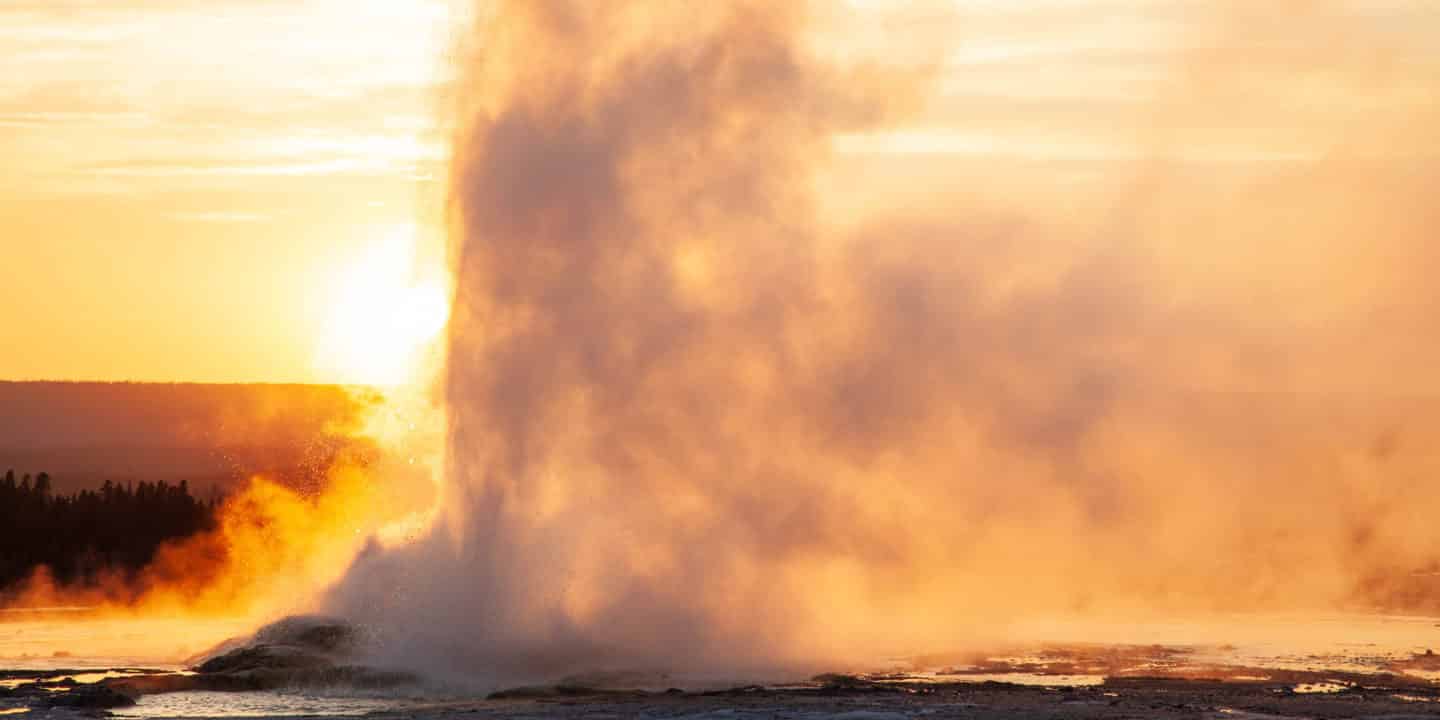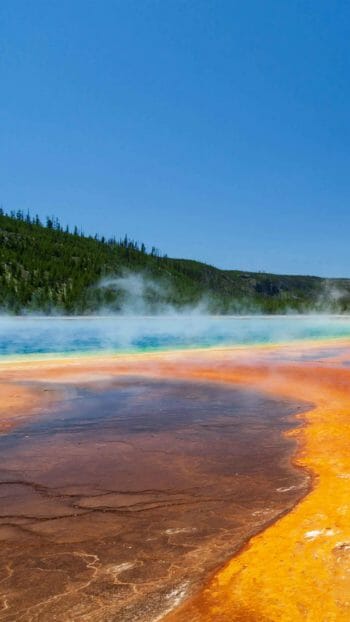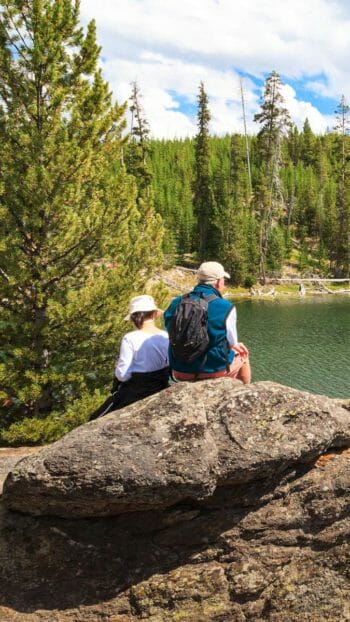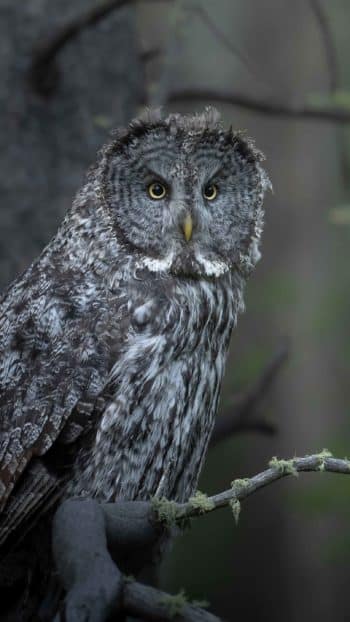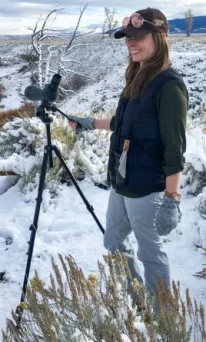Yellowstone National Park is famous for wondrous natural features like the Old Faithful Geyser and colorful hot springs like Grand Prismatic Spring. The park is a unique landscape filled with bubbling mud pots, water shooting up from the ground, swirling colors, and billowing steam at every turn. These awe-inspiring natural features make you feel like you’re on another planet. What many don’t realize is the fascinating story behind the creation of this amazing terrain. The driving force responsible for this geothermal activity is an ancient volcano of mammoth proportions that lies just beneath the surface of the park.
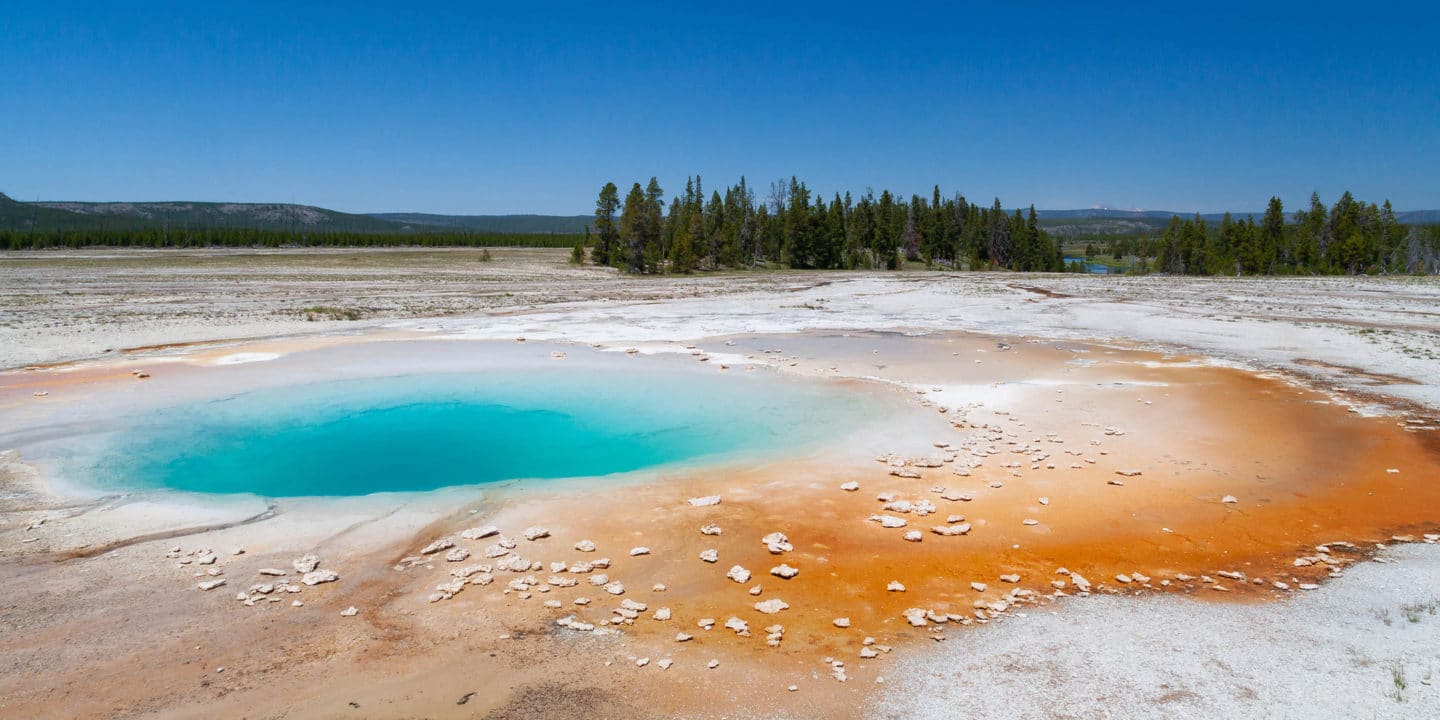
How Did the Yellowstone Volcano Form?
Volcanoes are formed along the boundaries of tectonic plates, but also around “hotspots” which are less common. Hotspots are areas where there is an unusual amount of heat that melts part of the upper mantle and the crust, forming magma. Magma is buoyant compared to the surrounding rock and gasses apply pressure, helping it rise, creating the right conditions for the formation of a volcano. Yellowstone is an example of hot spot volcanism, and an extreme one at that! It is considered one of the largest volcanoes in the world, capable of producing more than 240 cubic miles (1,000 cubic kilometers) of ash, magma, gas, and rock. It has the power to cause devastating destruction, and has done so in the past.
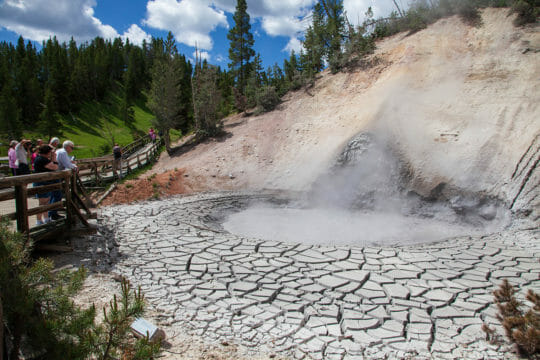
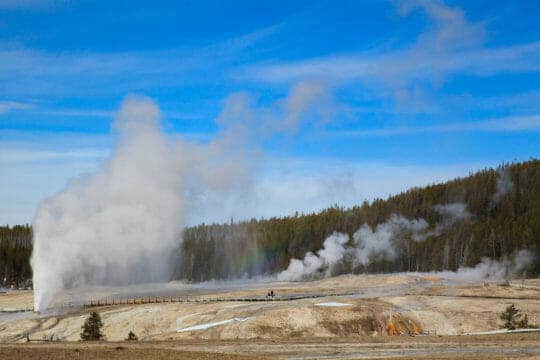
How Big is this Massive Volcano?
The size of the Yellowstone volcano is almost too enormous to comprehend. It consists of two separate magma chambers; the first sits only 5 miles beneath the surface and is estimated to be about 25 by 50 miles wide, reaching as far as 10 miles deep. In 2015 it was announced that a second, deeper chamber was discovered that begins 12 miles deep and stretches as far as 30 miles down. To give some perspective on size, this second chamber is so large, it could fill the Grand Canyon 11 times!
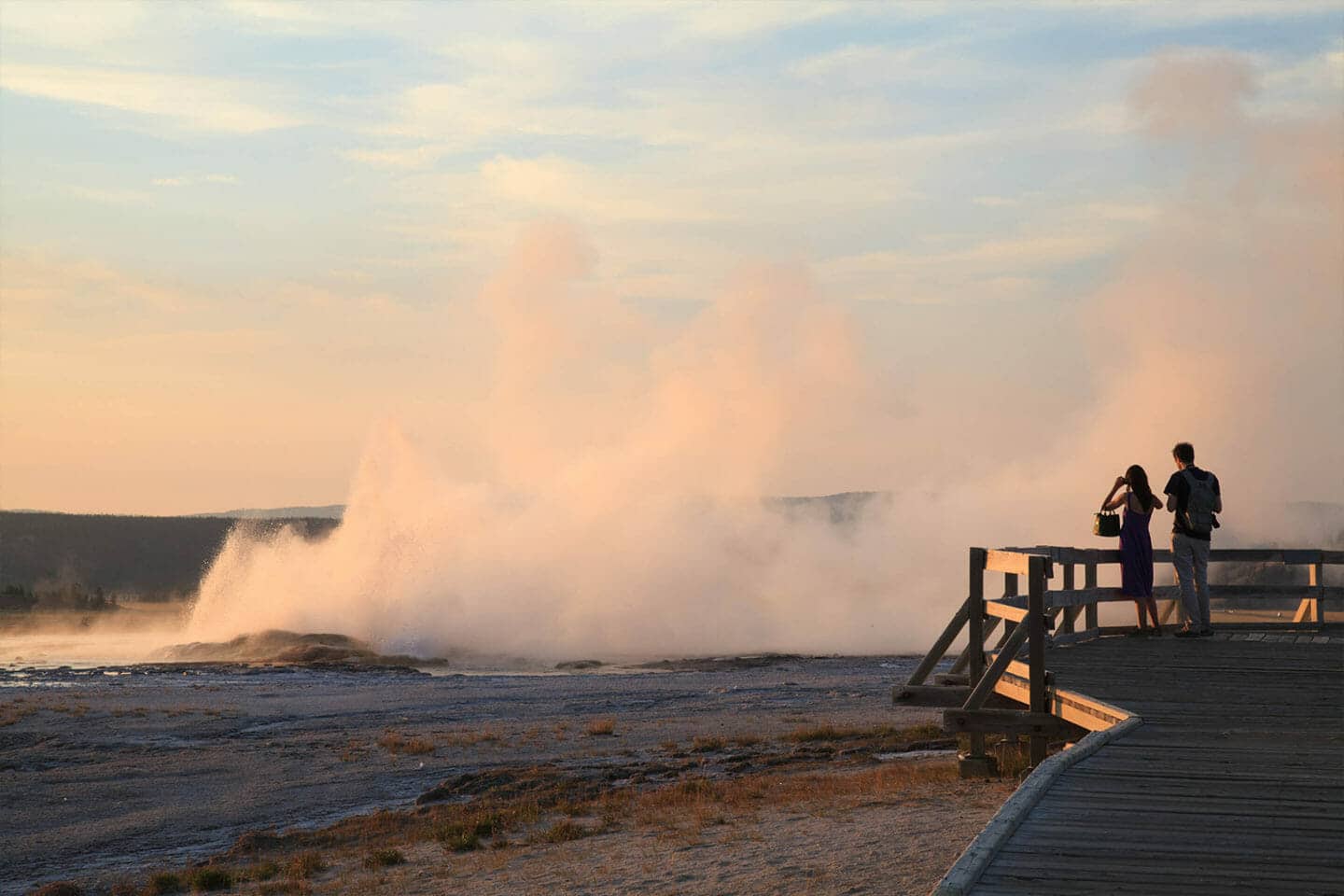
Yellowstone’s Last Major Eruption
Decoding the history of the Yellowstone hotspot is difficult; researchers believe it has been actively erupting for at least 16.5 million years with about 15-20 significant eruptions during this time. Most recently, there have been three major eruptions from the Yellowstone super volcano within the last 2.1 million years. We will be focusing on the latest one which occurred 640,000 years ago, before modern Homo sapiens evolved. This eruption was 2,500 times larger than Mt. Saint Helen’s in 1980 and is responsible for the geographical formation of today’s Yellowstone National Park.
Eruptions often leave “footprints” called calderas. This is not to be confused with a crater, which is formed by an outward explosion of rock. Calderas are formed after an eruption, when the land collapses in on itself devouring mountains, trees, and erasing the ecosystem that existed there. Not every eruption is a “caldera forming” event, however, and some can be considered mild in comparison. This most recent major eruption left behind a massive caldera measuring 30 x 45 miles which covers most of the lower loop in the park. It is so large that you do not have a sense of entering or exiting its boundaries, but if you know where to look you can see evidence of it in rock formations. During the eruption, incredible amounts of hot ash, gas, and magma spewed out and, suspended in the atmosphere, covered most of the continental US. This event likely blackened the skies and even slightly affected the global temperatures. Debris was found as far as Louisiana, and wind carried ash particles around the world.
The volume and frequency of volcanic activity eventually formed what we call the Yellowstone Plateau. A plateau is a flattened area of land that has been uplifted above its surroundings. This is a result of caldera formations and swelling of the earth’s surface from the upwelling of the heating magma chambers below the surface, which flattens the area and then raises it up. Thick lava flows also cover vast areas and fill up valleys and depressions, further flattening the surface. As you can see, there are many stages that have occurred over hundreds of thousands of years that have led us to the unique and extraordinary beauty that is now our beloved Yellowstone National Park!
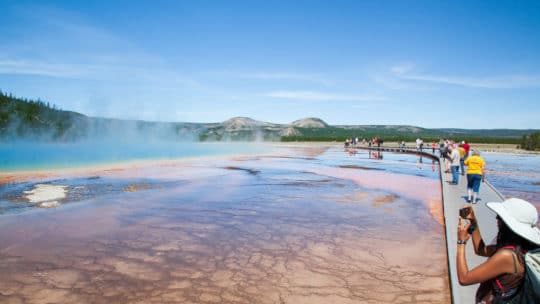
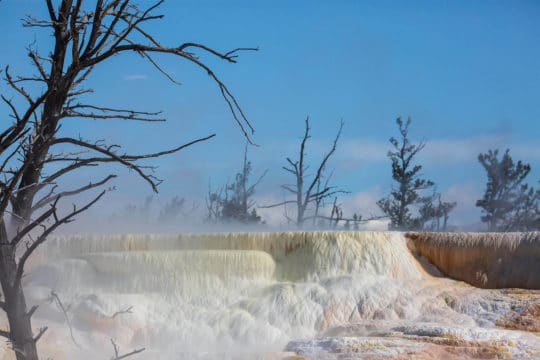
Types of Geothermal Features in Yellowstone
Every steaming, bubbling, spouting geothermal feature you see in the park is a direct result of the Yellowstone volcano. When you feel the heat emanating from them as you explore the boardwalks, you are feeling the energy from the volcano itself. Considering there are over 10,000 features, that’s a lot of activity! The sheer size and intensity of the magma chambers and how close they are to the surface is what makes this landscape so impressive and unlike anything else. Groundwater can reach 250 degrees Fahrenheit, and pH values range from less than 1 to 10 across the park. Depending on the rock and soil composition of an area and the intensity of the rising heat, five different types of geothermal features can form:
Hot springs: The most common feature in Yellowstone, hot springs are standing pools of hot water. Precipitation falls and seeps into the earth, becoming heated by the volcano and rising to the surface through natural plumbing systems. Heat circulates and dissipates consistently, so they do not erupt.
Geysers: Some of the most theatrical thermal features (and the most well-known thanks to Old Faithful), geysers shoot hot water straight from the ground into the air. Old Faithful is only one of about 500 geysers in Yellowstone, all varying in different timings, durations, and heights. They consist of a chamber below ground that fills up with groundwater, like hot springs do, except their plumbing is constricted. The heating water cannot rise easily to the surface, and pressure builds. These pressurized chambers experience extreme heat, some almost 450 degrees Fahrenheit, causing the pressure to force the water out of the ground in an eruption.
Mud pots: collecting water on impermeable rock, mud pots aren’t fed from underground like other features. There is plenty of heat and steam underneath which includes hydrogen sulfide gas, which is the rotten egg smell you’ll notice. Mud pots almost form their own little ecosystems with microorganisms that feed on the hydrogen sulfide gas, creating an extremely acidic environment, breaking down the rock and soil around them and making them ‘muddy’.
Fumaroles: Also called ‘steam vents’, these features don’t have an accumulation of water. They typically have extremely high temperatures, causing any and all moisture to immediately turn to steam.
Travertine Terraces: Thermal water rises up underneath limestone, moving through the porous rock. As it does, it dissolves the limestone into calcium carbonate, carrying it along to the surface where it is deposited, forming travertine. Over time the deposits become bigger and bigger, creating impressive formations like Mammoth Hot Springs Terraces.
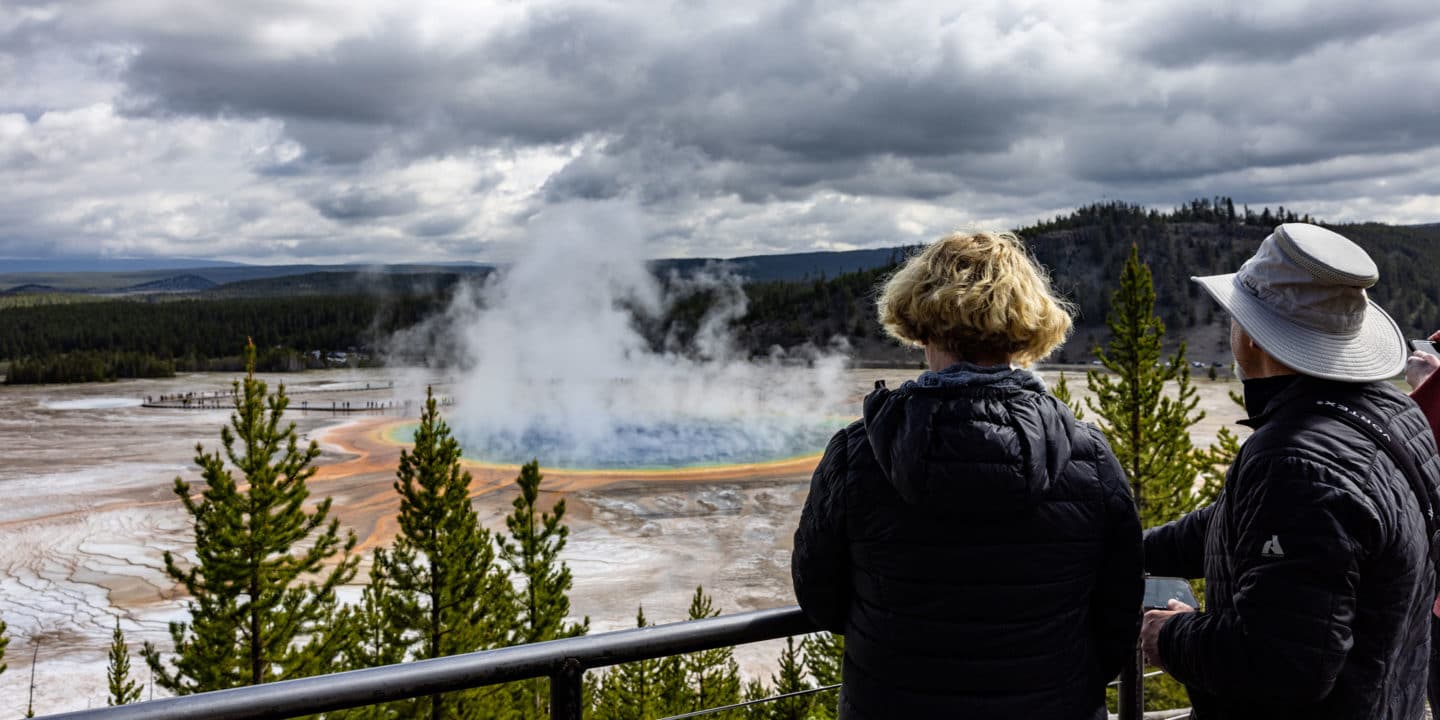
Yellowstone’s Geothermals Throughout History
Thanks to archeological evidence, we have learned that humans have used and inhabited the region for 11,000 years- long before US and European explorers came through. In fact, there are 26 current Native Tribes that have historic connections to lands and resources in the park, whether they traveled through for resources or called it home.
As the US expanded west establishing territories, Native Tribes were forcibly removed from their lands and moved onto designated reservations. When Yellowstone was established as the very first national park in 1872, US citizens of the East were encouraged to venture out to tour the park. However, there were fears of aggression from Native Tribes that gave tourists some trepidation, so efforts were made to remove all traces of Tribal presence from Yellowstone, both physically and symbolically. Tourists were told that Native people were never in Yellowstone to begin with, that Tribes were afraid of the thermal features and they had always stayed away from the park. This was reinforced by erasing all Native place names and replacing them with Anglo names, often foreboding in nature such as Dragon’s Mouth, Abyss Pool, Green Dragon Spring, and Sulphur Cauldron. Stories were told of Tribes regarding the park as a place inhabited by evil spirits that should be avoided. Quite the contrary, historic evidence tells a very different story. Native people saw the natural wonders of the region as evidence of sacred and favorable spirits who were there to help and protect. They used the springs to cook food, bath in for medicinal benefits, and even used some as burial grounds for their dead.
Native people respected and revered Yellowstone’s geothermals, and early Anglo explorers had similar feelings of awe and wonder when they came upon them. They also viewed the park as somewhat spiritual, but in a more sinister way. By the time the park was officially established, 60 places within the park had the name “Devil” and four had the name “Hell” in them. There was no mention of heaven, and even the famous guide Jim Bridger described Yellowstone as the “place where Hell bubbled up”. By the end of World War I, most mentions of Hell and the Devil were replaced with more pleasant nomenclatures.
It’s certainly understandable that a place like Yellowstone would be steeped in spirituality, whether it leans towards benevolence or wickedness. For something as incredibly powerful and mysterious as the Yellowstone volcano, it’s only natural that it stirs up something within us as we try to understand it, particularly before developing modern technology for studying volcanic activity.

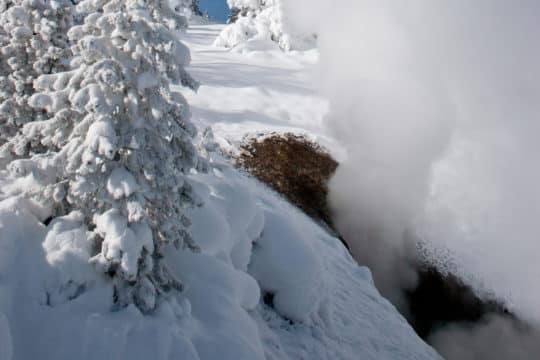
Safety When Visiting the Park
As visitors flocked to the park, overexuberance and a lack of knowledge led to many accidents with people falling into lethally hot water or acidic mud. Since 1890, there have been at least 22 deaths from hot springs recorded. Despite the park issuing safety warnings and laws designed for visitors’ protection, there are several incidents every year as people venture illegally off the designated boardwalks and suffer injuries. Deaths are rare, but they do happen in the worst-case scenarios.
When exploring Yellowstone, it is imperative to give the ecosystem the respect it deserves. These natural formations, while beautiful, are extremely dangerous. Your safety is your own responsibility once you enter the park. Never leave paths or boardwalks, and pay attention to signage warning of unstable ground. In thermally active areas, the surface around hot springs and other features is considered “thin crust”, meaning extremely hot water could be just under what looks like stable earth, but could break under your weight, causing you to fall through.
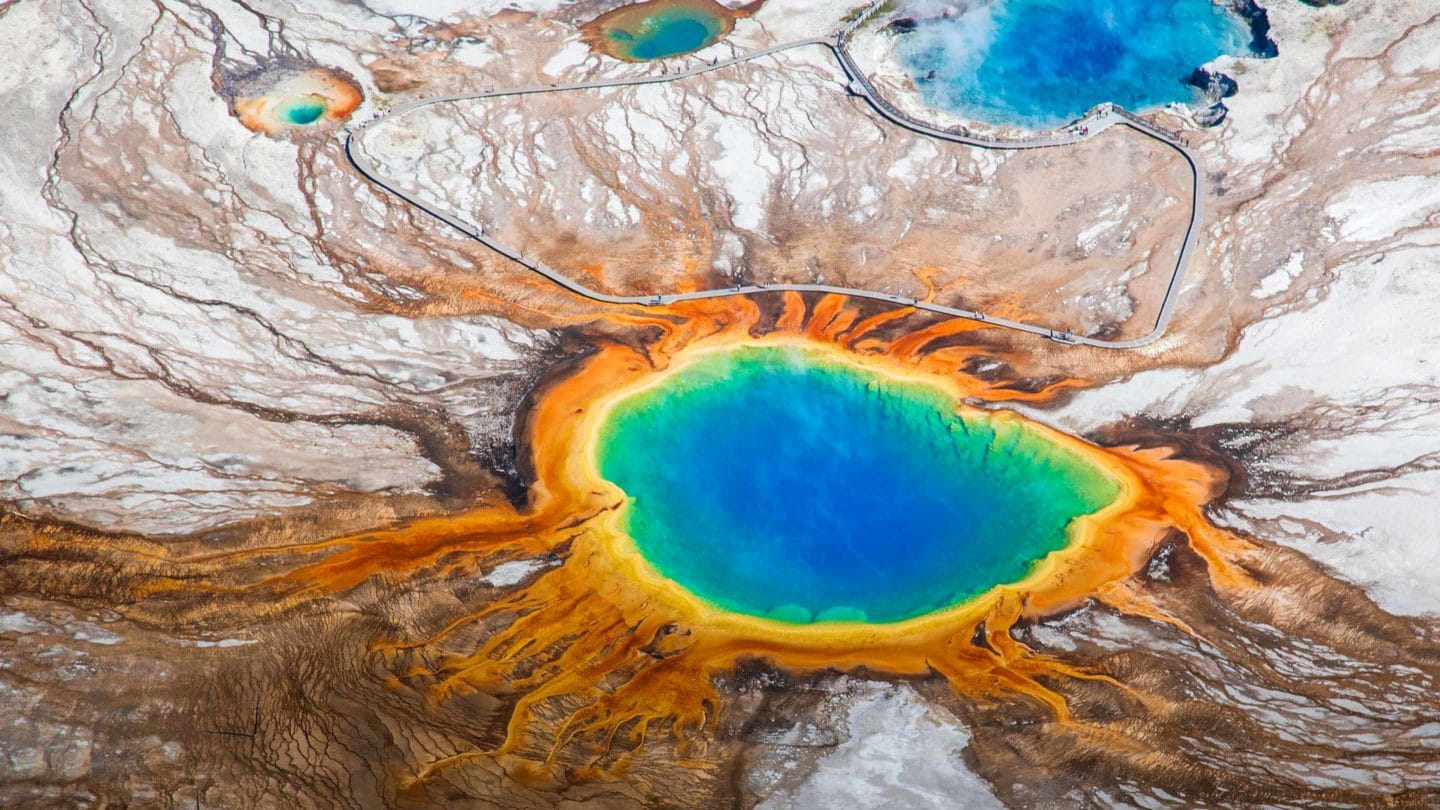
Experience Yellowstone’s Volcano for Yourself!
Yellowstone is more than the fantastic highlights that draw millions of visitors to wonder at. It is as a whole, above and below, a truly spectacular natural phenomenon unmatched by anything else on earth with a rich and varied history at its very core. Taking a Yellowstone Tour with Yellowstone Safari Company will guide you through the mesmerizing volcanic landscape while providing skillful interpretations of the spectacular sights you’ll see, leaving you with a deeper appreciation for what’s going on both above and below the surface!

